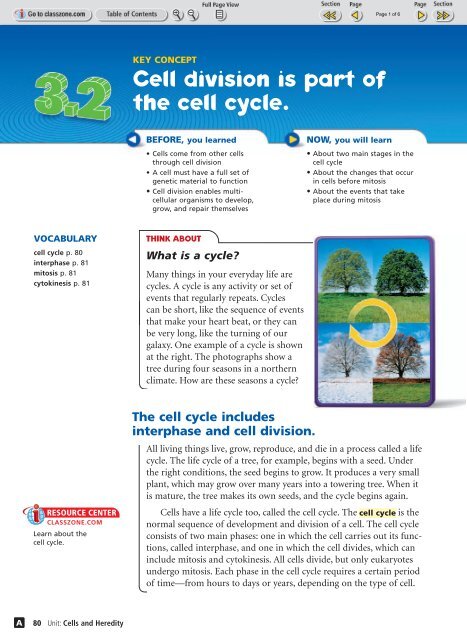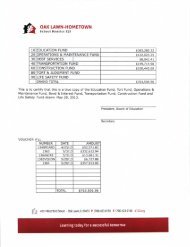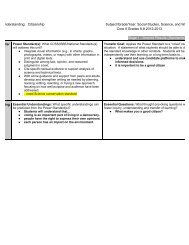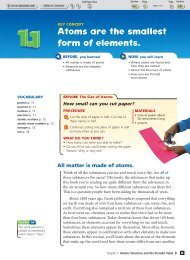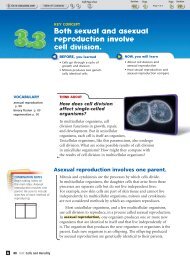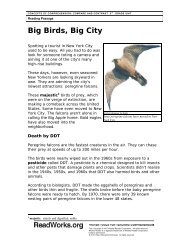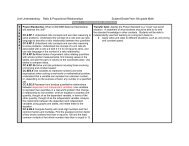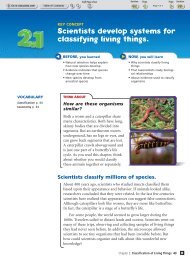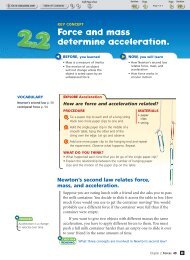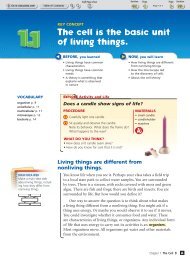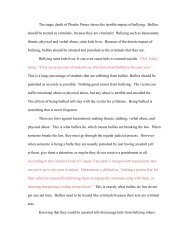(3.2) Cell division is part of the cell cycle. - Durant Road Middle School
(3.2) Cell division is part of the cell cycle. - Durant Road Middle School
(3.2) Cell division is part of the cell cycle. - Durant Road Middle School
You also want an ePaper? Increase the reach of your titles
YUMPU automatically turns print PDFs into web optimized ePapers that Google loves.
KEY CONCEPT<br />
<strong>Cell</strong> <strong>div<strong>is</strong>ion</strong> <strong>is</strong> <strong>part</strong> <strong>of</strong><br />
<strong>the</strong> <strong>cell</strong> <strong>cycle</strong>.<br />
BEFORE, you learned<br />
• <strong>Cell</strong>s come from o<strong>the</strong>r <strong>cell</strong>s<br />
through <strong>cell</strong> <strong>div<strong>is</strong>ion</strong><br />
•A <strong>cell</strong> must have a full set <strong>of</strong><br />
genetic material to function<br />
• <strong>Cell</strong> <strong>div<strong>is</strong>ion</strong> enables multi<strong>cell</strong>ular<br />
organ<strong>is</strong>ms to develop,<br />
grow, and repair <strong>the</strong>mselves<br />
NOW, you will learn<br />
• About two main stages in <strong>the</strong><br />
<strong>cell</strong> <strong>cycle</strong><br />
• About <strong>the</strong> changes that occur<br />
in <strong>cell</strong>s before mitos<strong>is</strong><br />
• About <strong>the</strong> events that take<br />
place during mitos<strong>is</strong><br />
VOCABULARY<br />
<strong>cell</strong> <strong>cycle</strong> p. 80<br />
interphase p. 81<br />
mitos<strong>is</strong> p. 81<br />
cytokines<strong>is</strong> p. 81<br />
THINK ABOUT<br />
What <strong>is</strong> a <strong>cycle</strong>?<br />
Many things in your everyday life are<br />
<strong>cycle</strong>s. A <strong>cycle</strong> <strong>is</strong> any activity or set <strong>of</strong><br />
events that regularly repeats. Cycles<br />
can be short, like <strong>the</strong> sequence <strong>of</strong> events<br />
that make your heart beat, or <strong>the</strong>y can<br />
be very long, like <strong>the</strong> turning <strong>of</strong> our<br />
galaxy. One example <strong>of</strong> a <strong>cycle</strong> <strong>is</strong> shown<br />
at <strong>the</strong> right. The photographs show a<br />
tree during four seasons in a nor<strong>the</strong>rn<br />
climate. How are <strong>the</strong>se seasons a <strong>cycle</strong>?<br />
RESOURCE CENTER<br />
CLASSZONE.COM<br />
Learn about <strong>the</strong><br />
<strong>cell</strong> <strong>cycle</strong>.<br />
The <strong>cell</strong> <strong>cycle</strong> includes<br />
interphase and <strong>cell</strong> <strong>div<strong>is</strong>ion</strong>.<br />
All living things live, grow, reproduce, and die in a process called a life<br />
<strong>cycle</strong>. The life <strong>cycle</strong> <strong>of</strong> a tree, for example, begins with a seed. Under<br />
<strong>the</strong> right conditions, <strong>the</strong> seed begins to grow. It produces a very small<br />
plant, which may grow over many years into a towering tree. When it<br />
<strong>is</strong> mature, <strong>the</strong> tree makes its own seeds, and <strong>the</strong> <strong>cycle</strong> begins again.<br />
<strong>Cell</strong>s have a life <strong>cycle</strong> too, called <strong>the</strong> <strong>cell</strong> <strong>cycle</strong>. The <strong>cell</strong> <strong>cycle</strong> <strong>is</strong> <strong>the</strong><br />
normal sequence <strong>of</strong> development and <strong>div<strong>is</strong>ion</strong> <strong>of</strong> a <strong>cell</strong>. The <strong>cell</strong> <strong>cycle</strong><br />
cons<strong>is</strong>ts <strong>of</strong> two main phases: one in which <strong>the</strong> <strong>cell</strong> carries out its functions,<br />
called interphase, and one in which <strong>the</strong> <strong>cell</strong> divides, which can<br />
include mitos<strong>is</strong> and cytokines<strong>is</strong>. All <strong>cell</strong>s divide, but only eukaryotes<br />
undergo mitos<strong>is</strong>. Each phase in <strong>the</strong> <strong>cell</strong> <strong>cycle</strong> requires a certain period<br />
<strong>of</strong> time—from hours to days or years, depending on <strong>the</strong> type <strong>of</strong> <strong>cell</strong>.<br />
EA<br />
80 Unit: <strong>Cell</strong>s and Heredity
Interphase<br />
Interphase <strong>is</strong> <strong>the</strong> <strong>part</strong> <strong>of</strong> <strong>the</strong> <strong>cell</strong> <strong>cycle</strong> during which a <strong>cell</strong> <strong>is</strong> not<br />
dividing. Much activity takes place in th<strong>is</strong> phase <strong>of</strong> <strong>the</strong> <strong>cell</strong>’s life.<br />
During interphase, <strong>the</strong> <strong>cell</strong> grows to about twice <strong>the</strong> size it was when<br />
it was first produced. The <strong>cell</strong> also engages in normal life activities,<br />
such as transporting materials in and transporting wastes out. Also,<br />
<strong>cell</strong>ular respiration occurs, which provides <strong>the</strong> energy <strong>the</strong> <strong>cell</strong> needs.<br />
Changes that occur during interphase prepare a <strong>cell</strong> for <strong>div<strong>is</strong>ion</strong>.<br />
Before a <strong>cell</strong> can divide, it duplicates its DNA exactly. Correct copying<br />
<strong>of</strong> <strong>the</strong> DNA <strong>is</strong> very important. It ensures that, after <strong>cell</strong> <strong>div<strong>is</strong>ion</strong>, each<br />
new <strong>cell</strong> gets a complete set <strong>of</strong> DNA. During most <strong>of</strong> interphase, <strong>the</strong><br />
DNA <strong>is</strong> in chromatin form.<br />
VOCABULARY<br />
Make a frame game<br />
diagram for interphase.<br />
Check Your Reading<br />
What <strong>cell</strong> processes occur during interphase?<br />
<strong>Cell</strong> Div<strong>is</strong>ion Phase<br />
Mitos<strong>is</strong> <strong>is</strong> <strong>the</strong> <strong>part</strong> <strong>of</strong> <strong>the</strong> <strong>cell</strong> <strong>cycle</strong> during which <strong>the</strong> nucleus divides.<br />
Prokaryotes do not undergo mitos<strong>is</strong> because <strong>the</strong>y have only one chromosome<br />
and no nucleus. In most <strong>cell</strong>s, mitos<strong>is</strong> <strong>is</strong> <strong>the</strong> shortest period<br />
in <strong>the</strong> life <strong>cycle</strong>. The function <strong>of</strong> mitos<strong>is</strong> <strong>is</strong> to move <strong>the</strong> DNA and<br />
o<strong>the</strong>r material in <strong>the</strong> parent <strong>cell</strong> into position for <strong>cell</strong> <strong>div<strong>is</strong>ion</strong>. When<br />
<strong>the</strong> <strong>cell</strong> divides, each new <strong>cell</strong> gets a full set <strong>of</strong> DNA and o<strong>the</strong>r <strong>cell</strong><br />
structures. Cytokines<strong>is</strong> (SY-toh-kuh-NEE-sihs) <strong>is</strong> <strong>the</strong> <strong>div<strong>is</strong>ion</strong> <strong>of</strong> <strong>the</strong><br />
parent <strong>cell</strong>’s cytoplasm. Cytokines<strong>is</strong> occurs immediately after mitos<strong>is</strong>.<br />
<strong>Cell</strong> Cycle<br />
The events that happen during <strong>the</strong> life<br />
<strong>of</strong> a <strong>cell</strong> are called <strong>the</strong> <strong>cell</strong> <strong>cycle</strong>.<br />
1<br />
Interphase<br />
The <strong>cell</strong> <strong>cycle</strong> begins<br />
with interphase, which<br />
<strong>is</strong> <strong>the</strong> longest <strong>part</strong> <strong>of</strong><br />
<strong>the</strong> <strong>cell</strong> <strong>cycle</strong>.<br />
<strong>cell</strong> grows and carries<br />
out normal functions;<br />
organelles duplicate<br />
reading tip<br />
The arrows in <strong>the</strong> <strong>Cell</strong> Cycle<br />
diagram represent <strong>the</strong> passage<br />
<strong>of</strong> time. Interphase <strong>is</strong><br />
in red, mitos<strong>is</strong> <strong>is</strong> in purple,<br />
and cytokines<strong>is</strong> <strong>is</strong> in yellow.<br />
INTERPHASE<br />
2<br />
<strong>Cell</strong> Div<strong>is</strong>ion<br />
Phase<br />
After mitos<strong>is</strong> and<br />
cytokines<strong>is</strong> <strong>the</strong>re<br />
are two <strong>cell</strong>s. The <strong>cell</strong><br />
<strong>cycle</strong> <strong>the</strong>n begins<br />
again for each <strong>cell</strong>.<br />
MITOSIS<br />
CYTOKINESIS<br />
Telophase<br />
Anaphase<br />
Metaphase<br />
Prophase<br />
<strong>cell</strong> grows<br />
and prepares<br />
for mitos<strong>is</strong><br />
DNA replicates<br />
and chromosomes<br />
duplicate<br />
Chapter 3: <strong>Cell</strong> Div<strong>is</strong>ion 81<br />
EA
As a result <strong>of</strong> mitos<strong>is</strong> and cytokines<strong>is</strong>, <strong>the</strong> original—or parent—<br />
<strong>cell</strong> splits into two genetically identical daughter <strong>cell</strong>s. In th<strong>is</strong> case,<br />
<strong>the</strong> term daughter <strong>cell</strong> does not imply gender. It <strong>is</strong> a term scient<strong>is</strong>ts use<br />
to refer to <strong>the</strong>se new <strong>cell</strong>s. Each daughter <strong>cell</strong> comes from half <strong>of</strong> <strong>the</strong><br />
parent <strong>cell</strong>. Each daughter <strong>cell</strong> also receives a complete set <strong>of</strong> DNA<br />
from <strong>the</strong> parent <strong>cell</strong>.<br />
COMBINATION NOTES<br />
As you read, begin to take<br />
combination notes on <strong>the</strong><br />
main idea: <strong>Cell</strong> <strong>div<strong>is</strong>ion</strong><br />
produces two genetically<br />
identical <strong>cell</strong>s.<br />
<strong>Cell</strong> <strong>div<strong>is</strong>ion</strong> produces two genetically<br />
identical <strong>cell</strong>s.<br />
Recall that many <strong>cell</strong>s in your body are continually dividing into new<br />
<strong>cell</strong>s. The new <strong>cell</strong>s help your body grow, develop, repair itself, and<br />
replace worn-out <strong>part</strong>s. Though your body <strong>cell</strong>s divide at different<br />
rates, <strong>the</strong> same process—mitos<strong>is</strong>—divides <strong>the</strong>ir genetic material.<br />
<strong>Cell</strong> <strong>div<strong>is</strong>ion</strong> produces daughter <strong>cell</strong>s that are genetically identical<br />
to each o<strong>the</strong>r, as well as to <strong>the</strong>ir parent <strong>cell</strong>, which no longer ex<strong>is</strong>ts.<br />
Being genetically identical to <strong>the</strong>ir parent <strong>cell</strong> helps <strong>the</strong> new <strong>cell</strong>s function<br />
properly. A skin <strong>cell</strong>, for example, divides and produces skin <strong>cell</strong>s<br />
genetically identical to it. The new skin <strong>cell</strong>s will function in exactly<br />
<strong>the</strong> same way as <strong>the</strong> parent.<br />
Check Your Reading<br />
How are daughter <strong>cell</strong>s like <strong>the</strong> parent <strong>cell</strong>?<br />
VISUALIZATION<br />
CLASSZONE.COM<br />
Watch <strong>the</strong> process <strong>of</strong><br />
mitos<strong>is</strong> in action.<br />
Steps <strong>of</strong> Mitos<strong>is</strong><br />
The process <strong>of</strong> mitos<strong>is</strong> <strong>is</strong> essential in evenly dividing <strong>the</strong> genetic material<br />
between <strong>the</strong> daughter <strong>cell</strong>s. Although mitos<strong>is</strong> <strong>is</strong> a continuous<br />
process, scient<strong>is</strong>ts divide <strong>the</strong> events <strong>of</strong> mitos<strong>is</strong> into four phases.<br />
1<br />
2<br />
3<br />
Chromosomes form. During prophase, <strong>the</strong> DNA in <strong>the</strong> nucleus <strong>of</strong><br />
a <strong>cell</strong> forms chromosomes. Each chromosome cons<strong>is</strong>ts <strong>of</strong> two<br />
identical chromatids held toge<strong>the</strong>r by a centromere. The membrane<br />
around <strong>the</strong> nucleus d<strong>is</strong>appears.<br />
Chromosomes line up. The chromosomes line up in <strong>the</strong> middle<br />
<strong>of</strong> <strong>the</strong> <strong>cell</strong>. Th<strong>is</strong> stage <strong>is</strong> called metaphase.<br />
Chromosomes separate. During <strong>the</strong> stage called anaphase, <strong>the</strong><br />
chromatids split up, forming two chromosomes. The chromosomes<br />
are pulled to opposite sides <strong>of</strong> <strong>the</strong> <strong>cell</strong>.<br />
4 Nuclei form. A new nuclear membrane forms around each group<br />
<strong>of</strong> chromosomes during telophase. The chromosomes return to<br />
<strong>the</strong>ir threadlike chromatin form.<br />
Mitos<strong>is</strong> <strong>is</strong> fin<strong>is</strong>hed, and <strong>the</strong> <strong>cell</strong>’s genetic material has been divided.<br />
Following telophase <strong>the</strong> parent <strong>cell</strong>’s cytoplasm <strong>is</strong> divided to complete<br />
<strong>the</strong> parent <strong>cell</strong>’s <strong>div<strong>is</strong>ion</strong> into two entirely separate daughter <strong>cell</strong>s.<br />
EA<br />
82 Unit: <strong>Cell</strong>s and Heredity
<strong>Cell</strong> Div<strong>is</strong>ion<br />
Before mitos<strong>is</strong>, <strong>the</strong> <strong>cell</strong>’s DNA <strong>is</strong> copied during interphase.<br />
Interphase<br />
The <strong>cell</strong> has grown<br />
and <strong>is</strong> ready to divide.<br />
The nucleus contains<br />
two complete copies<br />
<strong>of</strong> DNA.<br />
Mitos<strong>is</strong> produces two new <strong>cell</strong>s with identical copies <strong>of</strong> DNA.<br />
1<br />
Chromosomes<br />
form.<br />
Prophase<br />
The nuclear membrane<br />
d<strong>is</strong>appears.<br />
Long strands <strong>of</strong> DNA<br />
condense to d<strong>is</strong>tinct<br />
chromosomes, each<br />
with two chromatids<br />
that are exact copies<br />
<strong>of</strong> each o<strong>the</strong>r.<br />
Chromosome<br />
chromatids<br />
centromere<br />
2<br />
Chromosomes<br />
line up.<br />
Metaphase<br />
Chromosomes line<br />
up in <strong>the</strong> middle <strong>of</strong><br />
<strong>the</strong> <strong>cell</strong>.<br />
3<br />
Chromosomes<br />
separate.<br />
Anaphase<br />
Each chromosome<br />
splits into<br />
two chromatids.<br />
Chromatids pull to<br />
<strong>the</strong> opposite ends<br />
<strong>of</strong> <strong>the</strong> <strong>cell</strong>.<br />
4<br />
Nuclei form.<br />
Telophase,<br />
Cytokines<strong>is</strong><br />
New nuclear<br />
membranes<br />
form.<br />
<strong>Cell</strong> pinches<br />
and divides<br />
Chapter 3: <strong>Cell</strong> Div<strong>is</strong>ion 83<br />
EA
eading tip<br />
As you read about<br />
cytokines<strong>is</strong> refer to <strong>the</strong><br />
images <strong>of</strong> plant and<br />
animal <strong>cell</strong>s on page 85.<br />
Div<strong>is</strong>ion <strong>of</strong> <strong>the</strong> Cytoplasm<br />
Cytokines<strong>is</strong>, or <strong>the</strong> <strong>div<strong>is</strong>ion</strong> <strong>of</strong> <strong>the</strong> parent <strong>cell</strong>’s cytoplasm, immediately<br />
follows mitos<strong>is</strong> in eukaryotic <strong>cell</strong>s. Cytokines<strong>is</strong> differs slightly in animal<br />
<strong>cell</strong>s and plant <strong>cell</strong>s.<br />
During cytokines<strong>is</strong> in an animal <strong>cell</strong>, a fiber ring forms in <strong>the</strong><br />
center <strong>of</strong> <strong>the</strong> dividing <strong>cell</strong>. The fiber ring contracts, pulling <strong>the</strong> <strong>cell</strong><br />
membrane inward. Eventually, <strong>the</strong> <strong>cell</strong> <strong>is</strong> pinched into two<br />
daughter <strong>cell</strong>s.<br />
In a plant <strong>cell</strong>, <strong>the</strong> <strong>cell</strong> wall prevents <strong>the</strong> <strong>cell</strong> membrane from<br />
being pulled inward. A structure called a <strong>cell</strong> plate grows between <strong>the</strong><br />
two new nuclei. The <strong>cell</strong> plate develops into a membrane and eventually<br />
becomes <strong>part</strong> <strong>of</strong> <strong>the</strong> <strong>cell</strong> wall <strong>of</strong> each <strong>of</strong> <strong>the</strong> new <strong>cell</strong>s.<br />
Check Your Reading<br />
How does cytokines<strong>is</strong> differ in plant <strong>cell</strong>s and animal <strong>cell</strong>s?<br />
<strong>Cell</strong> Div<strong>is</strong>ion<br />
How can you model mitos<strong>is</strong>?<br />
PROCEDURE<br />
1<br />
2<br />
Divide <strong>the</strong> poster board into six spaces, and draw arrows from one<br />
space to <strong>the</strong> next to indicate a <strong>cycle</strong>. Label <strong>the</strong> spaces, in order,<br />
“Interphase,” “Prophase,” “Metaphase,” “Anaphase,” “Telophase,”<br />
and “Cytokines<strong>is</strong>.”<br />
In each space, make a model <strong>of</strong> a <strong>cell</strong> and its DNA in <strong>the</strong> indicated phase.<br />
Make sure you represent <strong>the</strong> <strong>cell</strong> membrane, <strong>the</strong> nuclear membrane—when<br />
it <strong>is</strong> present—and <strong>the</strong> DNA.<br />
WHAT DO YOU THINK?<br />
• In which phases <strong>is</strong> <strong>the</strong> nuclear membrane present?<br />
• In which phases <strong>is</strong> <strong>the</strong> DNA present as chromosomes?<br />
• What do <strong>the</strong> arrows in your model show?<br />
SKILL FOCUS<br />
Making models<br />
MATERIALS<br />
• poster board<br />
• markers<br />
•pipe cleaners<br />
• packing peanuts<br />
•glue<br />
• sc<strong>is</strong>sors<br />
• yarn<br />
TIME<br />
30 minutes<br />
CHALLENGE How do you think <strong>cell</strong> <strong>div<strong>is</strong>ion</strong> would<br />
differ in prokaryotic <strong>cell</strong>s? Do you think <strong>cell</strong> <strong>div<strong>is</strong>ion</strong><br />
in prokaryotic <strong>cell</strong>s would be more or less complex<br />
than in eukaryotic <strong>cell</strong>s? Make drawings to show<br />
how you think a prokaryotic <strong>cell</strong> might divide.<br />
EA<br />
84 Unit: <strong>Cell</strong>s and Heredity
Cytokines<strong>is</strong><br />
Cytokines<strong>is</strong> happens in both plant and animal <strong>cell</strong>s.<br />
Animal <strong>cell</strong> The <strong>cell</strong><br />
membrane pinches; membrane<br />
forms around each <strong>cell</strong>.<br />
Plant <strong>cell</strong> A <strong>cell</strong> plate<br />
forms where <strong>the</strong> <strong>cell</strong> wall<br />
will divide <strong>the</strong> two <strong>cell</strong>s.<br />
COMPARE AND CONTRAST How does <strong>the</strong> process <strong>of</strong> cytokines<strong>is</strong> in <strong>the</strong><br />
animal <strong>cell</strong> on <strong>the</strong> left differ from that <strong>of</strong> <strong>the</strong> plant <strong>cell</strong> on <strong>the</strong> right?<br />
The two daughter <strong>cell</strong>s are now completely separated. Each <strong>is</strong><br />
surrounded by a <strong>cell</strong> membrane. Each daughter <strong>cell</strong> has about half<br />
<strong>of</strong> its parent <strong>cell</strong>’s cytoplasm. Though daughter <strong>cell</strong>s are identical to<br />
<strong>the</strong>ir parent <strong>cell</strong>, <strong>the</strong>y are smaller. After <strong>div<strong>is</strong>ion</strong>, <strong>cell</strong>s enter a period<br />
<strong>of</strong> growth, during which <strong>the</strong>y take in <strong>the</strong> resources <strong>the</strong>y need to<br />
increase <strong>the</strong> amount <strong>of</strong> <strong>the</strong>ir cytoplasm and to grow to full size. When<br />
<strong>cell</strong>s are fully grown, <strong>the</strong>y are about <strong>the</strong> same size as <strong>the</strong> parent <strong>cell</strong><br />
was before <strong>div<strong>is</strong>ion</strong>.<br />
Check Your Reading<br />
What happens to <strong>cell</strong>s after cytokines<strong>is</strong>?<br />
KEY CONCEPTS<br />
1. What are <strong>the</strong> two main <strong>part</strong>s<br />
<strong>of</strong> <strong>the</strong> <strong>cell</strong> <strong>cycle</strong>?<br />
2. Describe <strong>the</strong> state <strong>of</strong> a <strong>cell</strong><br />
about to start mitos<strong>is</strong>.<br />
3. How <strong>is</strong> <strong>the</strong> genetic material in<br />
two daughter <strong>cell</strong>s similar to<br />
<strong>the</strong> genetic material in a<br />
parent <strong>cell</strong>?<br />
CRITICAL THINKING<br />
4. Sequence Describe in<br />
order <strong>the</strong> steps that occur<br />
during mitos<strong>is</strong>.<br />
5. Compare and Contrast<br />
How <strong>is</strong> cytokines<strong>is</strong> in plant <strong>cell</strong>s<br />
similar to cytokines<strong>is</strong> in animal<br />
<strong>cell</strong>s? How <strong>is</strong> it different?<br />
CHALLENGE<br />
6. Infer You know that mitos<strong>is</strong><br />
does not happen in prokaryotes.<br />
Do you think cytokines<strong>is</strong><br />
happens in prokaryotes?<br />
Explain your answer.<br />
Chapter 3: <strong>Cell</strong> Div<strong>is</strong>ion 85<br />
EA


